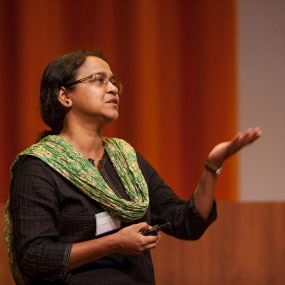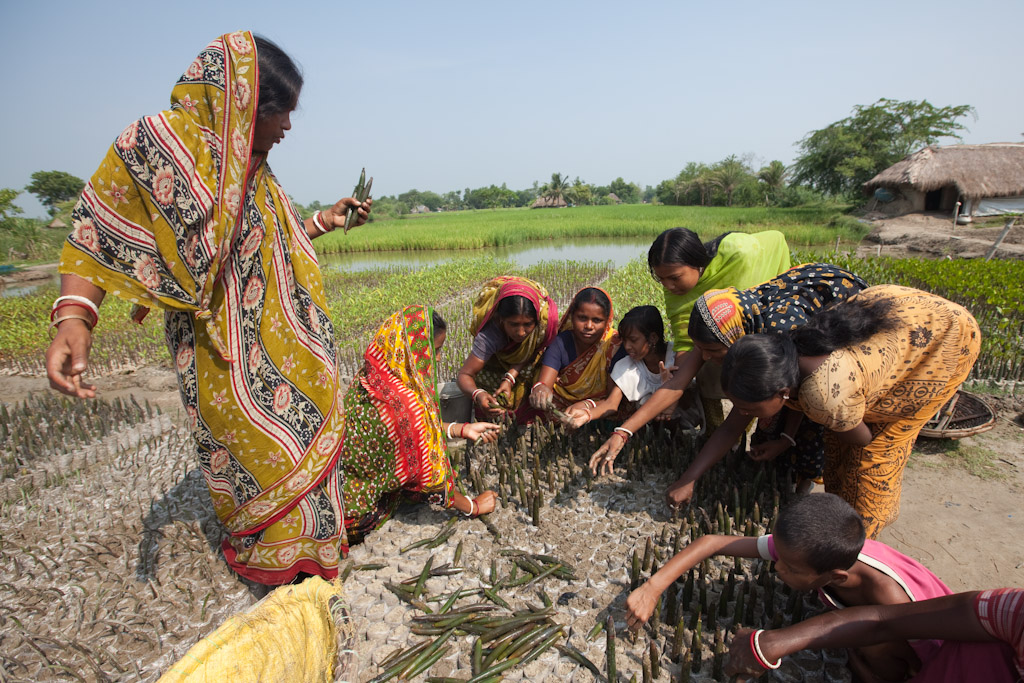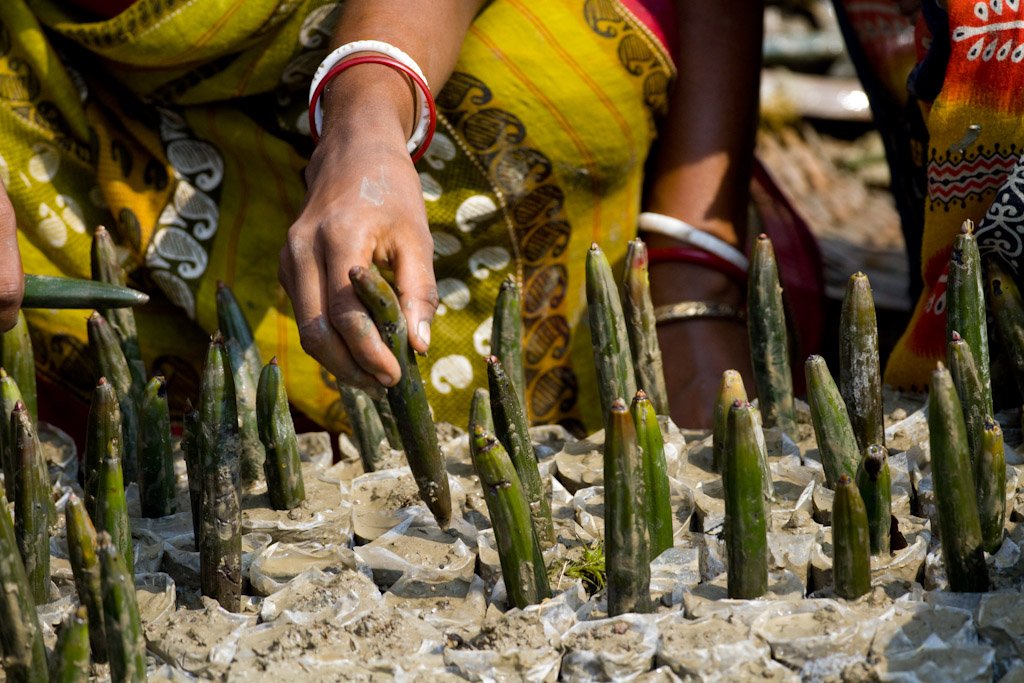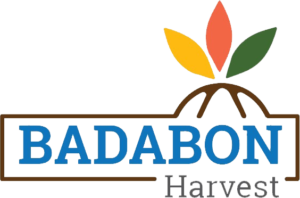Located in the State of West Bengal (Eastern India) in the Ganges Delta, the Sundarbans are an archipelago of islands that form the largest estuarine mangrove ecosystem in the world. Home to nearly 4.5 million people, the Sundarbans forest is threatened due to climate change and accelerated sea-level rise. In 2011, Livelihoods Venture and the Indian Foundation Nature Environment and Wildlife Society (NEWS), a local NGO, joined forces to restore more than 16 million mangroves to strengthen the embankments, restore biodiversity and create economic opportunities for the local communities. The project is sequestrating a total of 700, 000 tons of CO2 over 20 years.
Ajanta Dey, Joint Secretary & Programme Director of NEWS, explains how the Livelihoods-NEWS project helped restore a fragile ecosystem with strong social and economic impacts, as well as bring the NGO’s core mission on nature conservation at scale.

Ajanta Dey, Joint Secretary & Programme Director, Nature Environment & Wildlife Society (NEWS) local NGO
Livelihoods Venture: How did the Livelihoods-NEWS project in the Sundarbans start?
“Back in 2010, in NEWS, we were a team of 10, inventing models on how to restore natural ecosystems and submitting them to the government. Our priority was to restore the mangrove ecosystem in the Sundarbans, which is essential for the livelihoods of the communities, especially after the tropical cyclone had hit the region in 2009. We had the model, but the government financing sources couldn’t provide us with the right resources or availability to bring our mission at scale. The Livelihoods Carbon Fund was a huge opportunity for us to deploy a replicable model, with strong impact for the communities. From the beginning, Livelihoods and NEWS’ common goal was to find impactful solutions. And carbon offsetting was a powerful way to achieve this”.
Livelihoods Venture: what benefits did the Livelihoods-NEWS project bring to the communities in the Sundarbans?
“High-scale biodiversity preservation and improved livelihoods:
What is key about the Livelihoods Carbon Funds projects is that beyond carbon impact, they generate strong impact for biodiversity preservation and the livelihoods of local communities. The challenge ahead of us was huge: we had to rebuild an entire ecosystem of mangroves, that constitutes a natural barrier against flooding, but that is also rich in biodiversity. The Sundarbans provide a unique ecosystem and a rich wildlife habitat that was getting threatened and particularly depleted in the biosphere region. What we have achieved together is the restoration of 5,200 hectares of mangroves that have helped improve biodiversity significantly. Fish, birds, shrimps and other crustaceans are back. Today, we count 500 crab collectors instead of 50 before the project was launched, in one afforested island alone and a big bird colony has developed there.”
“The project relies on a strong economic inclusion for the benefit of the local communities:
Second, the Livelihoods Carbon project relies on a strong economic inclusion. It was entirely built with the local communities and adapted to their local needs. At the beginning it was not easy: we had to convince the marginalised communities in the Sundarbans to join the programme. We spent months discussing closely with the communities to explain to them the dimensions of the project, select the areas to restore, select the mangroves species, prepare the nurseries before plantation. We also spent a lot of time structuring our work to implement growth surveillance, reporting and make sure we had the right framework to succeed in our mission in the long run as it is a 20-year project.
During the first four years, the inhabitants of the project’s area, specifically women, invested a lot of time and dedication to prepare the nurseries, transport and plant the trees, water them during the dry seasons and protect them as they grew.
Today, when the village inhabitants visit the mangroves, they are all dressed in green sarees, to show they are on “mangrove watch”, forming a green brigade. They fill in their reports, watch how the trees grow, check their viability. What strongly stands out after 10 years of project implementation is how proud and strongly involved they remain. We count more than 300 mangrove representatives who are fully integrated in the programme and have become the real actors of mangrove restoration.”


“We created the Badabon Harvest brand to develop income generating activities for the farmers:

Badabon Harvest is a brand and programme that uses the increasing demand for fresh, natural and organically cultivated food in Kolkata as an engine for community development in Sundarban.
Learn more here.
In exchange of their time spent to pilot the mangroves growth, we decided to run a program to develop economic opportunities for them and facilitate connections with the Kolkata market where there was a strong demand for fresh, natural and organically cultivated food. In 2018, we created the Badabon Harvest brand with a group of marginalised farmers, essentially the mangrove stewards, to help them improve their revenues through livestock breeding, organic products commercialisation, improvement of agricultural practices, fish farming etc. This was a profound transformation for NEWS: we now had a different approach from research-based nature conservation to field action-based conservation linked livelihood development along with facilitating the developing of business activities. Through the Badabon Harvest brand, their own company, the farmers now sell their products to the Kolkata market, and this has been achieved thanks to the Livelihoods support which managed to link mangrove restoration with strong economic opportunities for the local communities.”
Livelihoods Venture: what has been the carbon impact of mangrove restoration?
“Another key component of the Livelihoods Carbon Fund model is that it relies on upfront financing. This is a unique feature in impact financing: companies invest at risk in the project. But financing mangrove restoration is profitable for these companies and for the planet. Mangroves are among the best carbon sequestration agents: they stock a lot of carbon in their roots and as they grow. This carbon is transformed into carbon offsets that are useful for the private companies aiming for zero net emissions by reducing the carbon emissions in their value chain and by offsetting what they cannot yet reduce.”
Livelihoods Venture: In which ways did the Livelihoods Carbon Fund help bring NEWS’ mission on nature conservation at scale?
“NGOs like ours dream about scaling up. The Livelihoods project and our many interactions with the Livelihoods team have transformed us in many ways: our vision, our identity, our capacity to work with the local communities. It has opened many doors with policy makers, partners, fish producers. Just because of the scalability, we had to spread this model of conservation in the Sundarbans, on both scientific and ecology levels. We have widened up our activities and helped our organisation moving from pure conservation focus to conservation linked income generating activities for the local communities. It has been a long and fruitful journey. Protecting or restoring nature cannot work if local communities are not envolved.
As an organization, we moved from 10 employees, including 1 accountant and in 1 office, to 38 employees, 5 accountants and 5 offices! In the Sundarbans, now everybody knows us as “The Green Party”.
Livelihoods Venture: What challenges await the carbon offsetting projects in the next years?
“We need to move on to building integrated mangrove projects. We need to work on the whole value chain of the mangrove ecosystem, hand in hand with the government, smallholder farmers, civil society organisation, Institutes, exporters, importers… because this really is a multi-stakeholder mission.
At global level, carbon offsetting projects are necessary to restore key natural ecosystems and reduce CO2 emissions. But they are not the only solution. Today, we need stronger political action and policies to reduce CO2 emissions efficiently, but also to store carbon in soil and forests. It is particularly true for developed countries but also for developing economies like India. The Livelihoods Fund relies on a model that links two different worlds: developed and developing countries, the private and the public sectors’ challenges for the communities and the environment.”
Photo credits: Hellio Vaningen / Livelihoods Funds


